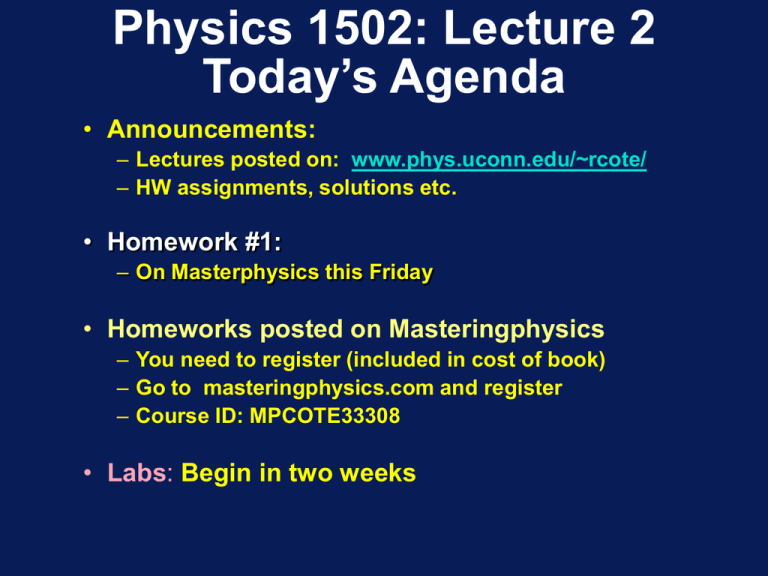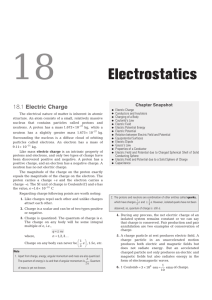Lecture 2
advertisement

Physics 1502: Lecture 2 Today’s Agenda • Announcements: – Lectures posted on: www.phys.uconn.edu/~rcote/ – HW assignments, solutions etc. • Homework #1: – On Masterphysics this Friday • Homeworks posted on Masteringphysics – You need to register (included in cost of book) – Go to masteringphysics.com and register – Course ID: MPCOTE33308 • Labs: Begin in two weeks Today’s Topic : • End of Chapter 20 – – – – – Define Electric Field in terms of force on "test charge" Electric Field Lines Example Calculations Continuous charge distributions => integrate Moving charges: Use Newton’s law • Demonstration of Mastering Physics Coulomb's Law q1 q2 r F21 r F12 q1q2 1 F12= r 4pe0 r2 SI Units: • r in meters • q in Coulombs • F in Newtons 1 = 8.987 109 N m2/C2 4pe0 Charles Coulomb (1736-1806) Electric Fields The force, F, on any charge q due to some collection of charges is always proportional to q: Introducing the Electric Field: a quantity, which is independent of that charge q, and depends only upon its position relative to the collection of charges. A FIELD is something that can be defined anywhere in space it can be a scalar field (e.g., a Temperature Field) it can be a vector field (as we have for the Electric Field) Lecture 2, ACT 1 • Two charges, Q1 and Q2 , fixed along the x-axis as shown, produce an electric field E at a point (x,y) = (0,d) which is directed along the negative y-axis. d – Which of the following statements is true? y E Q1 (a) Both charges Q1 and Q2 must be positive. (b) Both charges Q1 and Q2 must be negative. (c) The charges Q1 and Q2 must have opposite signs. Q2 x How Can We Visualize the E Field? • Vector Maps: arrow length indicates vector magnitude + O • Graphs: Ex, Ey, Ez as a function of (x, y, z) Er, Eq, EF as a function of (r, q, F) Ex x + chg Example E y r • Consider a point charge fixed at the origin of a co-ordinate system as shown. – The following graphs represent the functional dependence of the Electric Field. y= Q f i(x) 0.67 Er Er 0 0 0 9 r x= 0 f 2p x • As the distance from the charge increases, the field falls off as 1/r2. • At fixed r, the radial component of the field is a constant, independent of f!! x Lecture 2, ACT 2 y r • Consider a point charge fixed at the origin of a co-ordinate system as shown. – Which of the following graphs best represents the functional dependence of the Electric Field at the point (r,f)? Ex Fixed r>0 0 Q 2p 0 x Ex Ex f f f 2p 0 f 2p Another Way to Visualize E ... • The Old Way: Vector Maps • A New Way: Electric Field Lines O + O + O + chg - chg • Lines leave positive charges and return to negative charges • Number of lines leaving/entering charge = amount of charge • Tangent of line = direction of E • Density of lines = magnitude of E y Electric Dipole +Q What is the Electric Field generated by this charge arrangement? a q E a r x E -Q Calculate for a pt along x-axis: (x,0) Ex = ?? Symmetry Ey = ?? Electric Dipole: Field Lines • Lines leave positive charge and return to negative charge What can we observe about E? • Ex(x,0) = 0 • Ex(0,y) = 0 • Field largest in space between the two charges • We derived: ... for r >> a, Field Lines from 2 Like Charges • Note the field lines from 2 like charges are quite different from the field lines of 2 opposite charges (the electric dipole) • There is a zero halfway between charges • r>>a: looks like field of point charge (+2q) at origin. Lecture 2, ACT 3 y 2a +Q a a x a -Q • Consider a dipole aligned with the y-axis as shown. – Which of the following statements about Ex(2a,a) is q1 true? q2 (a) Ex(2a,a) < 0 (b) Ex(2a,a) = 0 (c) Ex(2a,a) > 0 E y Electric Dipole +Q a a -Q x What is the Electric Field generated by this charge arrangement? Now calculate for a pt along y-axis: (0,y) Ey = ?? Ex = ?? Coulomb Force Radial Ey (0, y ) = E x (0, y) = 0 Ey (0, y ) = Q 1 1 2 2 4 pe0 y - a y a ( ) ( + ) Q 4pe0 4ay 2 2 a y4 1 - 2 y y Electric Dipole +Q r a a x -Q For pts along x-axis: Case of special interest: (antennas, molecules) r>>a For pts along y-axis: E x (r, 0) = 0 E y (r, 0) = -2 E x (0, r ) = 0 1 Qa 4 pe 0 (r 2 + a 2 )3/2 Ey (0, r ) = For r >>a, For r >>a, E y (r ,0 ) -2 1 Qa 4pe0 r 3 Q 4pe0 4ar 2 2 a r 4 1 - 2 r Ey (0, r ) +4 1 Qa 4pe0 r3 y Electric Dipole Summary +Q r Case of special interest: a (antennas, molecules) x a r>>a -Q • Along x-axis • Along y-axis E x (r, 0) = 0 E y (r ,0 ) -2 E x (0, r ) = 0 1 Qa 4 pe0 r3 1 Qa Ey (0, r ) +4 4pe0 r3 • Along arbitrary angle Q E Qa 1 E 3 r dipole moment with Electric Fields from Continuous Charge Distributions See Examples in text • Principles (Coulomb's Law + Law of Superposition) remain the same. Only change: S P Dq r r DE Dq DE = k e 2 rˆ r Dqi dq ˆ E = k e lim 2 ri = k e 2 rˆ Dq0 ri i V r Charge Densities • How do we represent the charge “Q” on an extended object? total charge Q small pieces of charge dq • Line of charge: l = charge per unit length • Surface of charge: s = charge per unit area dq = l dx dq = s dA • Volume of charge: r = charge per unit volume dq = r dV Example: Infinite line of charge r E(r) = ? ++++++++++++++++++++++++++ How do we approach this calculation? r E(r) = ? In words: ++++++++++++++++++++++++++ “add up the electric field contribution from each bit of charge, using superposition of the results to get the final field” In practice: • Use Coulomb’s Law to find the E field per segment of charge • Plan to integrate along the line… • x: from -to + OR q: from -p/2to +p/2 Q +++++++++++++++ • Any symmetries ? This may help for easy cancellations. Infinite Line of Charge y dE Charge density = l Q r r' ++++++++++++++++ dx We need to add up the E field contributions from all segments dx along the line. x Infinite Line of Charge We use Coulomb’s Law to find dE: dq dE = 4 pe0 r2 dE y 1 Q r' r But what is dq in terms of dx? ++++++++++++++++ x dx dq = l dx what is r’ in terms of r? And r= Therefore, But x and q are not independent! r cosq dE = dE = ldx 4 pe 0 (r / cos q )2 1 1 l cos2 qdx 4 pe 0 r2 x = r tanq dx = r sec2q dq dE = 1 ldq 4 pe0 r Infinite Line of Charge • Components: dEx = - dEy = + 1 ldq 4 pe0 r 1 ldq 4 pe0 r Ey sin q dE q y Ex q r cosq ++++++++++++++++ x dx • Integrate: +p/2 1 ldq Ex = dEx = - sin q 4 r - p / 2 pe0 Ey = dEy = r' + p/ 2 1 ldq cosq 4 - p / 2 pe0 r Infinite Line of Charge y • Solution: dE +p / 2 sinq dq = 0 -p / 2 Ex = 0 +p / 2 Ey = cosq d q = 2 Q 2l 4 pe 0 r -p / 2 • Conclusion: 1 r r' ++++++++++++++++ x dx The Electric Field produced by an infinite line of charge is: – everywhere perpendicular to the line – is proportional to the charge density – decreases as 1/r. Lecture 2, ACT 4 • Consider a circular ring with a uniform charge distribution (l charge per unit length) as shown. The total charge of this ring is +Q. • The electric field at the origin is (a) (b) zero 1 2pl 4 pe0 R (c) 1 pRl 4 pe 0 R2 y + +++ + + + + + + + ++ + R + + + + + + + + x Summary Electric Field Distibutions Dipole Point Charge Infinite Line of Charge ~ 1 / R3 ~ 1 / R2 ~1/R Motion of Charged Particles in Electric Fields • Remember our definition of the Electric Field, F = qE • And remembering Physics 1501, qE F = ma a = m Now consider particles moving in fields. Note that for a charge moving in a constant field this is just like a particle moving near the earth’s surface. ax = 0 ay = constant vx = vox vy = voy + at x = xo + voxt y = yo + voyt + ½ at2 Motion of Charged Particles in Electric Fields • Consider the following set up, ++++++++++++++++++++++++++ e-------------------------For an electron beginning at rest at the bottom plate, what will be its speed when it crashes into the top plate? Spacing = 10 cm, E = 100 N/C, e = 1.6 x 10-19 C, m = 9.1 x 10-31 kg Motion of Charged Particles in Electric Fields ++++++++++++++++++++++++++ e-------------------------- vo = 0, yo = 0 vf2 – vo2 = 2aDx Or, qE 2 v f = 2 Dx m (1.6x10 -19 C )(100N /C ) (0.1m) v 2f = 2 -31 9.1x10 kg v f = 1.9x106 m / s Recap of today’s lecture • Define Electric Field in terms of force on "test charge" • Electric Field Lines • Example Calculations • Continuous charge distributions => integrate • Moving charges: Use Newton’s law • Homework #1 on Mastering Physics – From Chapter 20









